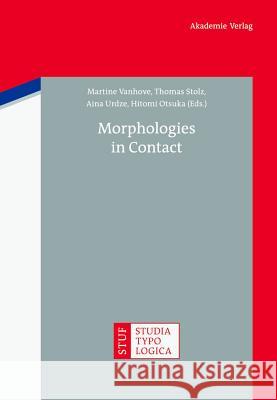Morphologies in Contact » książka
Morphologies in Contact
ISBN-13: 9783050057019 / Angielski / Twarda / 2012 / 340 str.
This collection of articles takes up the issue of Contact Morphology raised by David Wilkins in 1996. In the majority of contact-related studies, morphology is at best a marginal topic. According to the extant borrowing hierarchies, bound morphology is copied only rarely, if at all, because morphological copies presuppose long-term intensive contact with prior massive borrowing of content words and function words. On the other hand, especially in studies of morphological change, contact is often identified as the decisive factor which triggers the disintegration of morphological systems. However, it remains to be seen whether these two standard treatments of morphology in contact situations exhaust the phenomenology of Contact Morphology. The 14 papers of the present volume shed new light on the behavior of morphology under the conditions of language contact. Fresh empirical data from 40 languages world-wide are presented and new theory-based concepts are discussed. Morphologies in Contact is a first in the history of both morphology and language contact studies. It is meant to mark the beginning of an international research program which explores the entire range of aspects connected to morphologies in contact and thus, paves the way for a full-blown Contact Morphology qua linguistic discipline.
Dieser Sammelband greift den Begriff der Kontaktmorphologie (Contact Morphology) auf, der 1996 von David Wilkins geprägt wurde. Bisher gehen die meisten Sprachkontaktstudien davon aus, dass morphologische Strukturen selten entlehnt werden, da eine Kopie morphologischer Strukturen einen intensiven und langandauernden Sprachkontakt mit vorausgehender massiver Entlehnung von Lexemen und Funktionswörtern voraussetzt. Arbeiten zu morphologischen Veränderungen sehen Sprachkontakt dagegen häufig als entscheidende Ursache für die Auflösung des morphologischen Systems an.§Im vorliegenden Band wird untersucht, inwieweit diese Herangehensweisen der Phänomenologie der Kontaktmorphologie gerecht werden können. Die 14 Artikel geben Aufschluss über die Veränderung morphologischer Strukturen unter Sprachkontaktbedingungen. Es werden empirische Daten aus 40 Sprachen weltweit präsentiert und neue theoretische Konzepte diskutiert. Der Band markiert den Beginn eines internationalen Forschungsprogramms, das Morphologie im Sprachkontakt unter den unterschiedlichsten Blickwinkeln untersucht und so den Weg ebnet für die Etablierung von Kontaktmorphologie als eigenständige wissenschaftliche Disziplin.











